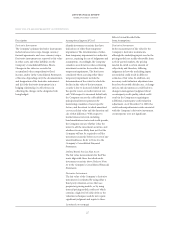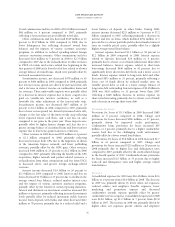American Express 2009 Annual Report Download - page 36
Download and view the complete annual report
Please find page 36 of the 2009 American Express annual report below. You can navigate through the pages in the report by either clicking on the pages listed below, or by using the keyword search tool below to find specific information within the annual report.
2009 FINANCIAL REVIEW
AMERICAN EXPRESS COMPANY
percent, respectively, in 2009.2Currency rate changes had a
minimal impact on the growth rates in 2008.
Results from continuing operations for 2009 included:
폷A $180 million ($113 million after-tax) benefit in the third
quarter related to the accounting for a net investment in
the Company’s consolidated foreign subsidiaries. See also
Business Segment Results – Corporate & Other below for
further discussion;
폷A $211 million ($135 million after-tax) gain in the second
quarter of 2009 on the sale of 50 percent of the Company’s
equity holdings of Industrial and Commercial Bank of
China (ICBC); and
폷A $190 million ($125 million after-tax) net charge related
to the Company’s reengineering initiatives.
Results from continuing operations for 2008 included:
폷A $600 million ($374 million after-tax) addition to U.S.
lending credit reserves reflecting a deterioration of credit
indicators in the second quarter of 2008;
폷A $449 million ($291 million after-tax) net charge,
primarily reflecting the restructuring costs related to the
Company’s reengineering initiatives in the fourth quarter
of 2008;
폷A $220 million ($138 million after-tax) reduction to the
fair market value of the Company’s interest-only strip; and
폷A $106 million ($66 million after-tax) charge in the fourth
quarter of 2008 to increase the Company’s Membership
Rewards liability, in connection with the Company’s
extension of its partnership arrangements with Delta.
Results from continuing operations for 2007 included:
폷A $1.13 billion ($700 million after-tax) gain for the initial
payment due March 31, 2008, from Visa as part of the
litigation settlement;
폷An $80 million ($50 million after-tax) gain in connection
with derivative and hedging instruments;
폷A $63 million ($39 million after-tax) gain relating to
amendments to the Company’s U.S. pension plans,
effective July 1, 2007, that reduced projected pension
obligations to plan participants;
2These currency rate adjustments assume a constant exchange rate
between periods for purposes of currency translation into U.S.
dollars (i.e., assumes the foreign exchange rates used to determine
results for the current year apply to the corresponding year-earlier
period against which such results are being compared).
Management believes that this presentation is helpful to investors
by making it easier to compare the Company’s performance from
one period to another without the variability caused by
fluctuations in currency exchange rates.
폷A $685 million ($430 million after-tax) charge related to
enhancements to the method of estimating Membership
Rewards liability;
폷A $438 million ($274 million after-tax) credit-related
charge due to experienced deterioration of credit indicators
in the latter part of 2007. This fourth quarter charge was
split between USCS cardmember loans and cardmember
receivables of $288 million and $96 million, respectively,
and included $54 million relating to a reduction in the fair
value of the Company’s retained subordinated interest in
securitized cardmember loans;
폷$211 million ($131 million after-tax) of incremental
business-building costs;
폷$74 million ($46 million after-tax) of Visa litigation-related
costs; and
폷A $50 million ($31 million after-tax) contribution to the
American Express Charitable Fund.
Also included in the 2007 results were $66 million
($43 million after-tax) of reengineering costs related to the
Company’s business travel, prepaid services, international
payments business and technology areas.
Total Revenues Net of Interest Expense
Consolidated total revenues net of interest expense for 2009 of
$24.5 billion were down $3.8 billion or 14 percent from 2008,
due to lower discount revenue, lower total interest income,
reduced securitization income, net, lower other commissions
and fees, reduced travel commissions and fees, and decreased
other revenues, partially offset by lower total interest expense.
Consolidated total revenues net of interest expense of $28.4
billion for 2008 were $806 million or 3 percent higher than
2007 primarily due to greater discount revenue, lower total
interest expense, higher other revenues, increased net card
fees and greater travel commissions and fees, partially offset
by lower securitization income, net, decreased interest income
and lower other commissions and fees.
Discount revenue for 2009 declined $1.6 billion or 11
percent as compared to 2008 to $13.4 billion as a result of a 9
percent decrease in worldwide billed business. The greater
decrease in discount revenue compared to billed business
primarily reflects growth in billed business related to GNS
where the Company shares the discount revenue with card
issuing partners, as well as a slight decline in the average
discount rate. The 9 percent decrease in worldwide billed
business in 2009 reflected decline in proprietary billed
business of 11 percent, offset by a 7 percent increase in billed
business related to GNS. The average discount rate was 2.54
percent, 2.55 percent, and 2.56 percent for 2009, 2008, and
2007, respectively. Over time, selective repricing initiatives,
changes in the mix of business, and volume-related pricing
discounts likely will result in some erosion of the average
discount rate.
34
























